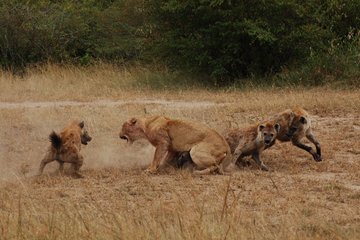For animal societies, cohesion comes at a cost
In a first for wild primates, scientists use ‘Fitbit’ technology on a troop of baboons to reveal the price of sticking together
From gaining valuable information to staying safe from predators, moving in a group can benefit animals – but at what cost? Researchers from the Max Planck Institute of Animal Behavior have provided rare insight into the physical price that animals pay for moving collectively. Using accelerometers – the equivalent of pedometers, or Fitbits – the team of scientists studied the detailed movement behavior and related energetic costs in a troop of 25 baboons. The study is the first to gain ultra-high resolution data on movement and energetics of a group of wild primates.

Baboons live in stable societies of up to 150 individuals, ranging from 30 kilo adult males to infants, and they travel together in these mixed-age groups. The findings show that all baboons compromise their preferred speed in order to keep the group together. But the smallest members are forced to adjust the most, thereby footing the greatest energy bill. The findings pose important questions about the costs and benefits of group living in wild animal societies. First author Roi Harel says: “The mixed-age societies of baboons resemble our own. Anybody who has tried to walk with a toddler knows the challenges of moving with someone who has a different physical ability. But cracking open this mystery in wild animal groups required technology to catch up.”
Senior author Meg Crofoot has been studying this baboon troop since 2012. “Locomotor capacity clearly governs the way animal societies move, but so far it’s been confined to laboratory studies,” says Crofoot, Director of the Ecology of Animal Societies at the Max Planck Institute of Animal Behavior. “The revolution in wearable technology now makes it possible to take locomotion research into the wild,” Crofoot adds.
Ultra-high resolution information on movement behavior
The researchers attached GPS trackers and accelerometers to 25 wild baboons – almost the entire troop – at the Mpala Research Centre in Kenya. When Crofoot began the study in 2012, she was the first to ever use GPS tracking with a large group of primates. In the current study, the GPS data, comprising ten million points, showed where animals moved. The accelerometer loggers, which provided 120 million readings, gave ultra-high resolution information on movement behavior, such as speed and number of steps.
The team found that animals have a preferred speed of movement depending on their body size: a large male with longer legs will naturally move with longer strides and require fewer steps to cover the same distance compared to a juvenile with smaller legs, for example. “The leg is like a big pendulum that you are swinging and that leads to a preferred gait, which translates into preferred speed of movement,” says Harel. Despite having a preferred speed, all baboons compromised to match the pace of their nearest neighbors—especially when the group spreads apart. The scientists say this provides evidence of democratic processes at work in a highly despotic species. “The dominant male clearly wields power over other baboons in one-on-one interactions,” says Harel. “But when it comes to collective movement, it seems like a shared decision-making process drives the group.”
Small individuals pay higher costs
Yet while all group members adjusted their movement patterns, they did so to differing degrees. Small baboons moved faster than their preferred pace, traveled longer routes, and expended relatively more energy than other size groups. While energy usage was not measured directly, the accelerometer data provided a proxy for energy expenditure that could be used to compare energetic costs among baboons. “Small individuals pay disproportionate costs associated with maintaining group cohesion, and this might be because they have the most to gain from group membership,” says Harel.
But do these behavioral changes actually keep the group together? To find out, the team used computer simulations to see how the group would look if everybody moved at their preferred pace, compared with if individuals adjusted their speed in response to others. The results showed that locomotor compromise is a requirement for cohesion. Harel explains: “Our simulations demonstrate that to replicate the levels of cohesion we observe in wild baboons, group members need to adjust their patterns of movement in response to who they are next to and where they are in the group.”
The scientists hope that this study will lead to a greater understanding of group living animals in their natural habitats. “Maybe the differing locomotor ability of individual animals actually puts an upper limit on how large groups can be. Maybe it forces certain individuals to group together, like mothers caring for toddlers. Maybe it’s driving complex organization,” says Crofoot. “Now we have a way of studying locomotion in the wild, we can finally merge this into how we think about the structure of animal societies,” she adds.












